 Operation and Maintenance
Operation and Maintenance
 Linux Operation and Maintenance
Linux Operation and Maintenance
 9 excellent code comparison tools under Linux [Recommended]
9 excellent code comparison tools under Linux [Recommended]
9 excellent code comparison tools under Linux [Recommended]
The following column linux tutorial will introduce you to 9 excellent code comparison tools under Linux. I hope it will be helpful to friends in need!
![9 excellent code comparison tools under Linux [Recommended]](https://img.php.cn/upload/article/000/000/020/5ef97f545f01f272.jpg)
When we write code, we often need to know the differences between two files, or between different versions of the same file. There is a very powerful tool called BeyondCompare under Windows. So what tools do you need to use under Linux?
This article introduces 9 commonly used code comparison tools under Linux, including not only command line tools, but also GUI interface tools, allowing you to easily perform code comparisons.
1. diff command
diff command is a powerful text comparison tool that comes with Linux, and it is very convenient to use. Regarding its use, I have written a separate article before. Click the link below to view it.
Teach you a trick on text comparison method under Linux
The diff command is pre-installed in most Linux distributions. It can compare two text files line by line and output Their differences. For more information, you can directly view its man manual.
$ man diff
However, although the diff command is powerful, its output is too impressive, not intuitive and clear. Therefore, in order to make up for this shortcoming, some big guys developed more powerful tools based on diff. Two are recommended here: colordiff and wdiff.
colordiff command
colordiff is a Perl script tool. Its output is the same as the diff command, but it will color the code and have syntax highlighting. At the same time, you can customize the theme if you don't like its default colors.
You can install colordiff to your computer by yourself and choose different installation commands according to different distributions.
$ yum install colordiff [On CentOS/RHEL/Fedora] $ dnf install colordiff [On Fedora 23+ version] $ sudo apt-get install colordiff [On Debian/Ubuntu/Mint]
Similarly, you can use the man command to view its help documentation:
$ man colordiff
wdiff command
diff command compares differences line by line, while wdiff Even more perverted is a word-for-word comparison. So if your text only changes a few words, using the wdiff command will be more efficient.
The installation command is as follows:
$ yum install wdiff [On CentOS/RHEL/Fedora] $ dnf install wdiff [On Fedora 23+ version] $ sudo apt-get install wdiff [On Debian/Ubuntu/Mint]
For more details, you can view its man manual.
$ man wdiff
2. The vimdiff command
vimdiff is equivalent to the vim -d command, which is the diff mode of the Vim editor.
This command is usually followed by two or more file names as parameters. These files will be opened in the split window of the Vim editor at the same time, and the parts with different contents in the files will be highlighted.
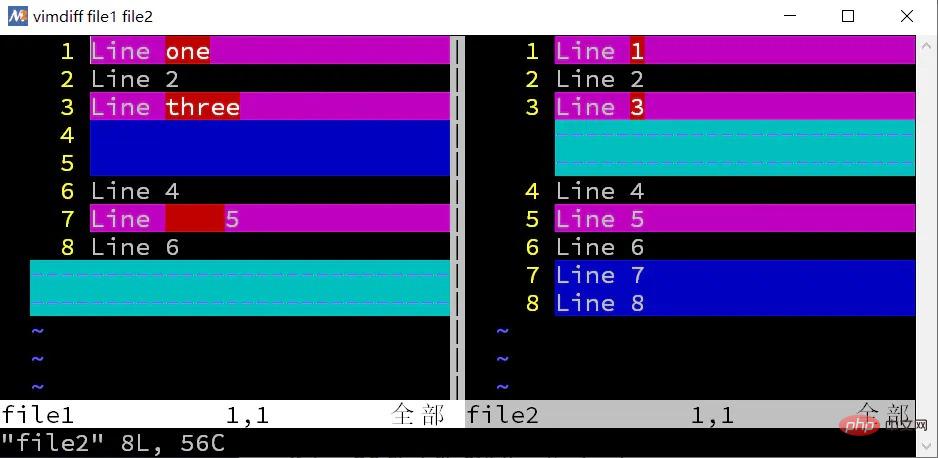
Its Chinese homepage is: http://vimcdoc.sourceforge.net/doc/diff.html
The two introduced above are Linux commands Let’s take a look at some GUI comparison tools.
3. Kompare
Kompare is a GUI tool based on diff. Users can easily see the differences between files and support merging these differences.
The features of Kompare are as follows:
- supports multiple diff formats;
- supports comparison between directories;
- supports reading diff file;
- Customized interface;
- Create and apply patch files of source files.
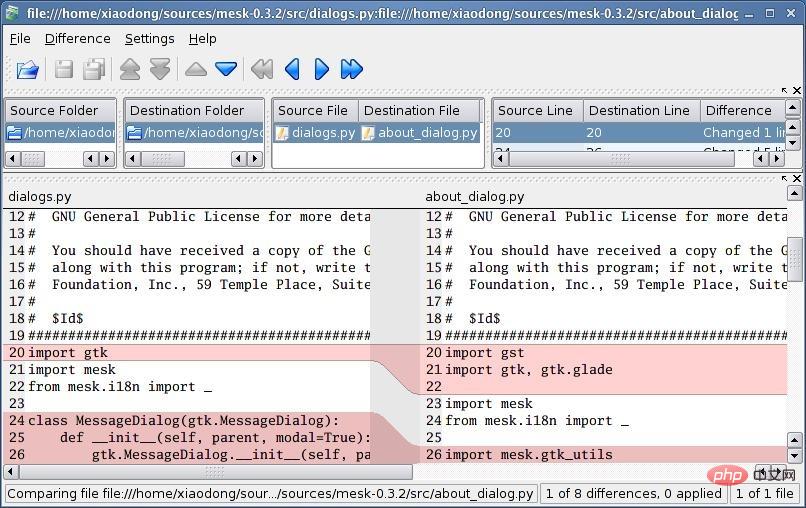
The homepage of this tool is: https://www.kde.org/applications/development/kompare/
4. DiffMerge
DiffMerge is a cross-platform GUI text comparison tool with three major platform versions: Linux, Windows, and macOS. We know that BeyondCompare is a paid software, so if your company's copyright requirements are relatively high, you may wish to consider the DiffMerge tool.
DiffMerge has two major functions: 1. Graphically display the changes between two files. Contains internal line highlighting and full editing support. 2. Graphically display the changes between the three files. Allows automatic merging (when it is safe to do so) and full editorial control over the resulting file.
It has the following features:
- Supports folder comparison;
- Integrated file browser;
- Highly configurable.

The homepage of this tool is: https://sourcegear.com/diffmerge/
5. Meld
Meld is a lightweight GUI code comparison tool that supports users to compare files and directories, and is highly integrated with version control software. But for software developers, its following features are particularly attractive:
- Perform two-way and three-way diffs and merges
- Easily navigate between differences and conflicts
- Compare two or three directories file by file, display new files, Missing and changed files
- Supports many version control systems, including Git, Mercurial, Bazaar and SVN, etc.

Its official website is: http://meldmerge.org/
6. Diffuse
Diffuse is another very popular, free, compact, and very simple GUI text difference comparison and merge tool. It is written in Python and has two main functions: file comparison and version control, allowing file Edit, merge, and output the differences between two files.
You can use it to view the text comparison summary and use the mouse to select a line in the file for editing. Its other features include:
- Syntax highlighting
- Shortcut keys for easy text navigation
- Unlimited undos
- Supports unicode encoded files
- Supports many version control systems, including Git, Mercurial, Bazaar and SVN, etc.

Its official website is: http://diffuse.sourceforge.net/
7. XXdiff
XXdiff is a free, powerful file and folder difference comparison and merging tool that can run on many Unix-like systems. However, it has a limitation that it does not support unicode files, and there is no way to edit files directly.
It has the following features:
- Recursively compare files and folders
- Highlight differences
- Merge differences and export results
- Support external diff tools, such as: GNU diff, SIG diff, Cleareddiff, and more
- Support script expansion
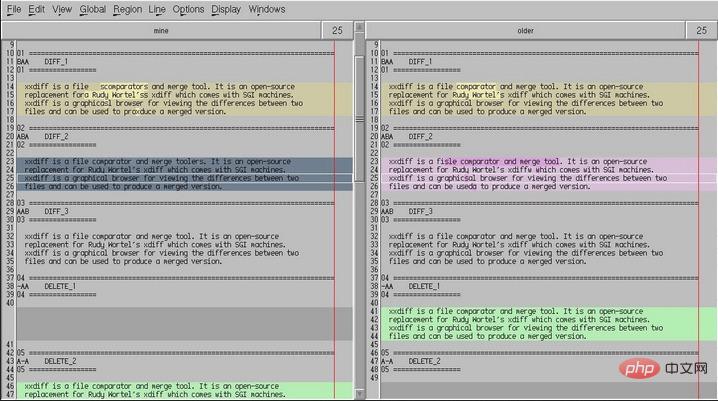
8. KDiff3
KDiff3 is another very powerful cross-platform difference comparison and merging tool. It is developed by KDevelop and can be used in Runs on all Unix-like platforms, including Linux, Mac OS, Windows, etc.
It can compare or merge two to three files or directories, with the following features:
- Can compare differences sentence by sentence and word by word
- Supports automatic merging
- Built-in editor, you can manually resolve conflicts
- Supports unicode, UTF-8 and other encoding formats
- Supports printing differences
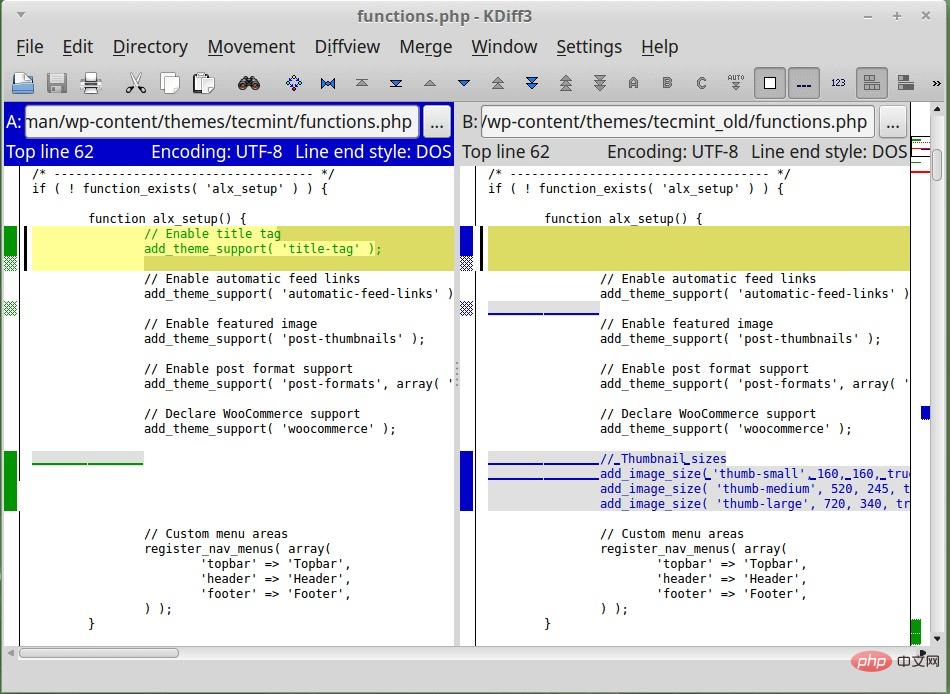
Its official website is: http://kdiff3.sourceforge.net/
9. TkDiff
TkDiff is another cross Platform, an easy-to-use GUI text comparison tool that can run on Linux, Windows and MacOS systems. It also provides a separate left and right interface for viewing two compared files.
However, it also has some features that other text comparison tools do not have, such as difference bookmarks and a navigation map that facilitates quick navigation of differences.
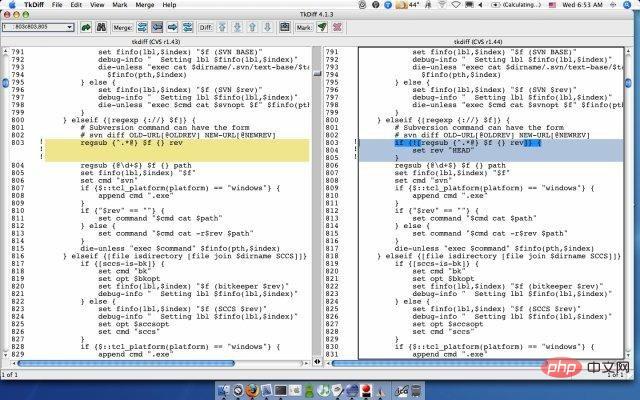
Its official website is: https://sourceforge.net/projects/tkdiff/
The above is the detailed content of 9 excellent code comparison tools under Linux [Recommended]. For more information, please follow other related articles on the PHP Chinese website!

Hot AI Tools

Undresser.AI Undress
AI-powered app for creating realistic nude photos

AI Clothes Remover
Online AI tool for removing clothes from photos.

Undress AI Tool
Undress images for free

Clothoff.io
AI clothes remover

Video Face Swap
Swap faces in any video effortlessly with our completely free AI face swap tool!

Hot Article

Hot Tools

Notepad++7.3.1
Easy-to-use and free code editor

SublimeText3 Chinese version
Chinese version, very easy to use

Zend Studio 13.0.1
Powerful PHP integrated development environment

Dreamweaver CS6
Visual web development tools

SublimeText3 Mac version
God-level code editing software (SublimeText3)

Hot Topics
 What computer configuration is required for vscode
Apr 15, 2025 pm 09:48 PM
What computer configuration is required for vscode
Apr 15, 2025 pm 09:48 PM
VS Code system requirements: Operating system: Windows 10 and above, macOS 10.12 and above, Linux distribution processor: minimum 1.6 GHz, recommended 2.0 GHz and above memory: minimum 512 MB, recommended 4 GB and above storage space: minimum 250 MB, recommended 1 GB and above other requirements: stable network connection, Xorg/Wayland (Linux)
 Linux Architecture: Unveiling the 5 Basic Components
Apr 20, 2025 am 12:04 AM
Linux Architecture: Unveiling the 5 Basic Components
Apr 20, 2025 am 12:04 AM
The five basic components of the Linux system are: 1. Kernel, 2. System library, 3. System utilities, 4. Graphical user interface, 5. Applications. The kernel manages hardware resources, the system library provides precompiled functions, system utilities are used for system management, the GUI provides visual interaction, and applications use these components to implement functions.
 vscode terminal usage tutorial
Apr 15, 2025 pm 10:09 PM
vscode terminal usage tutorial
Apr 15, 2025 pm 10:09 PM
vscode built-in terminal is a development tool that allows running commands and scripts within the editor to simplify the development process. How to use vscode terminal: Open the terminal with the shortcut key (Ctrl/Cmd). Enter a command or run the script. Use hotkeys (such as Ctrl L to clear the terminal). Change the working directory (such as the cd command). Advanced features include debug mode, automatic code snippet completion, and interactive command history.
 How to check the warehouse address of git
Apr 17, 2025 pm 01:54 PM
How to check the warehouse address of git
Apr 17, 2025 pm 01:54 PM
To view the Git repository address, perform the following steps: 1. Open the command line and navigate to the repository directory; 2. Run the "git remote -v" command; 3. View the repository name in the output and its corresponding address.
 Where to write code in vscode
Apr 15, 2025 pm 09:54 PM
Where to write code in vscode
Apr 15, 2025 pm 09:54 PM
Writing code in Visual Studio Code (VSCode) is simple and easy to use. Just install VSCode, create a project, select a language, create a file, write code, save and run it. The advantages of VSCode include cross-platform, free and open source, powerful features, rich extensions, and lightweight and fast.
 How to run java code in notepad
Apr 16, 2025 pm 07:39 PM
How to run java code in notepad
Apr 16, 2025 pm 07:39 PM
Although Notepad cannot run Java code directly, it can be achieved by using other tools: using the command line compiler (javac) to generate a bytecode file (filename.class). Use the Java interpreter (java) to interpret bytecode, execute the code, and output the result.
 What is the main purpose of Linux?
Apr 16, 2025 am 12:19 AM
What is the main purpose of Linux?
Apr 16, 2025 am 12:19 AM
The main uses of Linux include: 1. Server operating system, 2. Embedded system, 3. Desktop operating system, 4. Development and testing environment. Linux excels in these areas, providing stability, security and efficient development tools.
 vscode terminal command cannot be used
Apr 15, 2025 pm 10:03 PM
vscode terminal command cannot be used
Apr 15, 2025 pm 10:03 PM
Causes and solutions for the VS Code terminal commands not available: The necessary tools are not installed (Windows: WSL; macOS: Xcode command line tools) Path configuration is wrong (add executable files to PATH environment variables) Permission issues (run VS Code as administrator) Firewall or proxy restrictions (check settings, unrestrictions) Terminal settings are incorrect (enable use of external terminals) VS Code installation is corrupt (reinstall or update) Terminal configuration is incompatible (try different terminal types or commands) Specific environment variables are missing (set necessary environment variables)





